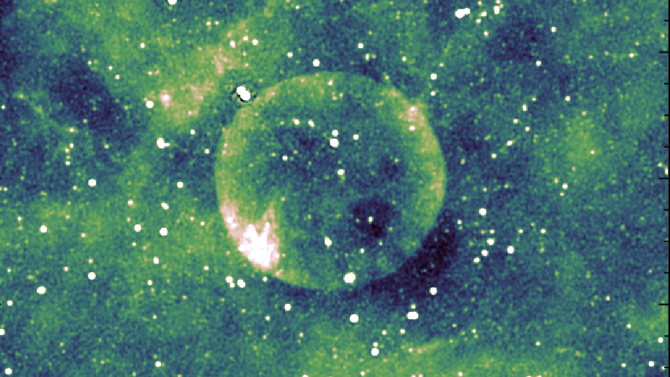Glowing Cloud of Rocket Fuel Captured in Night Sky Photo

A mysterious cloud that glowed in the night sky above the Atlantic Ocean on the night of March 12 was actually a spray of unused rocket fuel, released following a launch from Cape Canaveral Air Force Station, Florida.
Keen-eyed skywatcher Scott Gauer sent us this photograph of the glowing fuel cloud — which appears as a small fan of light in the sky — from Danville, Pennsylvania. The fuel came from an Atlas V rocket launched by NASA and carrying four satellites that make up the Magnetospheric Multiscale mission, or MMS, a science experiment that will study energetic events in Earth's magnetic field.
The rocket leaped off the launch pad at 10:44 p.m. EDT on March 12 (0244 GMT on March 13). Gauer took the photograph at around 1:18 a.m. EDT on March 13 (0518 GMT), about 2.5 hours after the launch, and said the fuel was visible with the naked eye for about 10 minutes. The fuel is apparently illuminated because it reflects sunlight.
Reports of the possible fuel dump sighting appeared earlier in the day on March 12.
The Atlas V rocket, built by United Launch Alliance, consisted of a single payload fairing carrying the MMS experiment, which comprises four satellites; two boosters; and a single-engine Centaur upper stage, which is what dumped the fuel. News of the fuel dump first came to Space.com from reporter Joe Rao, who learned about it from Cees Bassa, who posted a message about it on the SeeSat-L mail list.
The MMS mission consists of four satellites that will study a phenomenon called magnetic reconnection in Earth's magnetic field. This explosive phenomenon is a key driver of space weather, which includes solar storms, coronal mass ejections, geomagnetic storms and the auroras near the north and south poles.
The four satellites were released from the rocket at 5-minute intervals, beginning roughly 90 minutes after launch. The satellites will orbit together in a pyramid formation, which will allow them to collectively study magnetic reconnection over a three-dimensional region.
Get the Space.com Newsletter
Breaking space news, the latest updates on rocket launches, skywatching events and more!
In 2004, another rocket fuel dump was visible at night over the eastern United States and Canada. Many observers were surprised by the appearance of that "mystery cloud."
Follow Calla Cofield @callacofield. Follow us @Spacedotcom, Facebook and Google+. Original article on Space.com.
Join our Space Forums to keep talking space on the latest missions, night sky and more! And if you have a news tip, correction or comment, let us know at: community@space.com.

Calla Cofield joined Space.com's crew in October 2014. She enjoys writing about black holes, exploding stars, ripples in space-time, science in comic books, and all the mysteries of the cosmos. Prior to joining Space.com Calla worked as a freelance writer, with her work appearing in APS News, Symmetry magazine, Scientific American, Nature News, Physics World, and others. From 2010 to 2014 she was a producer for The Physics Central Podcast. Previously, Calla worked at the American Museum of Natural History in New York City (hands down the best office building ever) and SLAC National Accelerator Laboratory in California. Calla studied physics at the University of Massachusetts, Amherst and is originally from Sandy, Utah. In 2018, Calla left Space.com to join NASA's Jet Propulsion Laboratory media team where she oversees astronomy, physics, exoplanets and the Cold Atom Lab mission. She has been underground at three of the largest particle accelerators in the world and would really like to know what the heck dark matter is. Contact Calla via: E-Mail – Twitter
